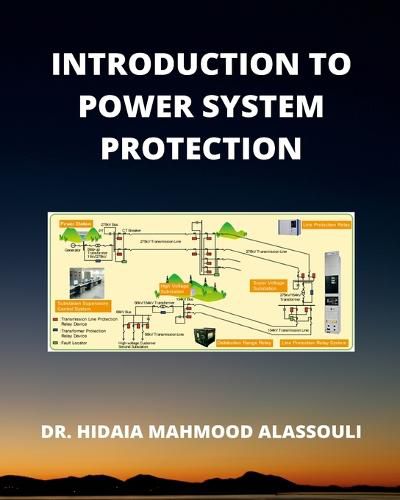Readings Newsletter
Become a Readings Member to make your shopping experience even easier.
Sign in or sign up for free!
You’re not far away from qualifying for FREE standard shipping within Australia
You’ve qualified for FREE standard shipping within Australia
The cart is loading…






This title is printed to order. This book may have been self-published. If so, we cannot guarantee the quality of the content. In the main most books will have gone through the editing process however some may not. We therefore suggest that you be aware of this before ordering this book. If in doubt check either the author or publisher’s details as we are unable to accept any returns unless they are faulty. Please contact us if you have any questions.
Power system protection systems have three basic components: Instrument transformers, Relays, Circuit breakers The function of the CT is to reproduce in its secondary winding a current I' that is proportional to the primary current I. The CT converts primary currents in the kiloamp range to secondary currents in the 0-5 ampere range for convenience of measurement. The function of the relay is to discriminate between normal operation and fault conditions. The OC relay in Figure 2 has an operating coil, which is connected to the CT secondary winding, and a set of contacts. When I' exceeds a specified ''pickup'' value, the operating coil causes the normally open contacts to close. When the relay contacts close, the trip coil of the circuit breaker is energized, which then causes the circuit breaker to open. System-protection components have the following design criteria: - Reliability: Operate dependably when fault conditions occur, even after remaining idle for months or years. Failure to do so may result in costly damages. - Selectivity: Avoid unnecessary, false trips. - Speed: Operate rapidly to minimize fault duration and equipment damage. Any intentional time delays should be precise. - Economy: Provide maximum protection at minimum cost. - Simplicity: Minimize protection equipment and circuitry. Since it is impossible to satisfy all these criteria simultaneously, compromises must be made in system protection. The book consists from the following sections: 1. Chapter 1: Power System Faults: 2. Chapter 2: Instrument Transformers. 3. Chapter 3: Overcurrent and Earth Fault Protection Relays. 4. Chapter 4: Radial System Protection. 5. Chapter 5: Zones of Protection. 6. Chapter 6: Differential Relays. 7. Chapter 7: Distance Relays. 8. Chapter 8: Transformer Protection. 9. Chapter 9: Generator Protection. 10. Chapter 10: Busbar Protection. 11. Chapter 11: Circuit Breakers. 12. Chapter 12: Fuses. 13. Chapter 13: References.
$9.00 standard shipping within Australia
FREE standard shipping within Australia for orders over $100.00
Express & International shipping calculated at checkout
This title is printed to order. This book may have been self-published. If so, we cannot guarantee the quality of the content. In the main most books will have gone through the editing process however some may not. We therefore suggest that you be aware of this before ordering this book. If in doubt check either the author or publisher’s details as we are unable to accept any returns unless they are faulty. Please contact us if you have any questions.
Power system protection systems have three basic components: Instrument transformers, Relays, Circuit breakers The function of the CT is to reproduce in its secondary winding a current I' that is proportional to the primary current I. The CT converts primary currents in the kiloamp range to secondary currents in the 0-5 ampere range for convenience of measurement. The function of the relay is to discriminate between normal operation and fault conditions. The OC relay in Figure 2 has an operating coil, which is connected to the CT secondary winding, and a set of contacts. When I' exceeds a specified ''pickup'' value, the operating coil causes the normally open contacts to close. When the relay contacts close, the trip coil of the circuit breaker is energized, which then causes the circuit breaker to open. System-protection components have the following design criteria: - Reliability: Operate dependably when fault conditions occur, even after remaining idle for months or years. Failure to do so may result in costly damages. - Selectivity: Avoid unnecessary, false trips. - Speed: Operate rapidly to minimize fault duration and equipment damage. Any intentional time delays should be precise. - Economy: Provide maximum protection at minimum cost. - Simplicity: Minimize protection equipment and circuitry. Since it is impossible to satisfy all these criteria simultaneously, compromises must be made in system protection. The book consists from the following sections: 1. Chapter 1: Power System Faults: 2. Chapter 2: Instrument Transformers. 3. Chapter 3: Overcurrent and Earth Fault Protection Relays. 4. Chapter 4: Radial System Protection. 5. Chapter 5: Zones of Protection. 6. Chapter 6: Differential Relays. 7. Chapter 7: Distance Relays. 8. Chapter 8: Transformer Protection. 9. Chapter 9: Generator Protection. 10. Chapter 10: Busbar Protection. 11. Chapter 11: Circuit Breakers. 12. Chapter 12: Fuses. 13. Chapter 13: References.